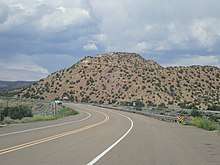Diamond Tail Formation
The Diamond Tail Formation is a geologic formation in New Mexico. It contains fossils characteristic of the late Paleocene or early Eocene.
| Diamond Tail Formation Stratigraphic range: late Paleocene to early Eocene | |
|---|---|
 Exposure of Diamond Tail Formation on Cerro Colorado, near Lamy, New Mexico | |
| Type | Formation |
| Underlies | Galisteo Formation |
| Overlies | Menefee Formation |
| Thickness | 442 m (1,450 ft) |
| Lithology | |
| Primary | Sandstone |
| Other | Mudstone |
| Location | |
| Region | Central New Mexico |
| Country | United States |
| Type section | |
| Named for | Diamond Tail Ranch |
| Named by | Lucas, Cather, Abbott, and Williamson |
| Year defined | 1997 |
Description
The Diamond Tail Formation consists of a lower member composed of sandstone and conglomeratic sandstone, a middle member of variegated mudstone, and an upper sandstone member. The formation crops out over a limited area between Sandia Crest and the southern Sangre de Cristo Mountains.
The formation likely correlates with the lower San Jose Formation.[1]
Fossils
The presence of Hyracotherium teeth dates the formation to the late Paleocene or early Eocene. [1]
History
The beds now designated as the Diamond Tail Formation were originally part of F.V. Hayden's Galisteo sand group.[2] By 1997, it was clear that these beds were separated from the remainder of the Galisteo by a significant regional unconformity, and they were split off into the Diamond Tail Formation, named after exposures near Diamond Tail Ranch.[1]
Footnotes
- Lucas et al. 1997
- Hayden 1869
References
- Hayden, F.V. (1869). United States Geologic Survey of New Mexico and Colorado.
- Lucas, Spencer G.; Cather, Steven M.; Abbott, John C.; Williamson, Thomas E. (November 1997). "Stratigraphy and tectonic implications of Paleogene strata in the Laramide Galisteo Basin, north-central New Mexico" (PDF). New Mexico Geology.